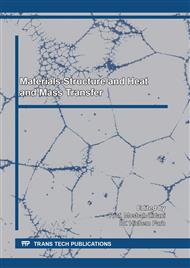[1]
T. Lant, D.L. Robinson, B. Spafford, J. Storesund, Review of weld repair procedures for low alloy steels designed to minimise the risk of future cracking. Int. J. Press. Vessels Pip.78 (2001) 813-818.
DOI: 10.1016/s0308-0161(01)00094-1
Google Scholar
[2]
W. Lucjan, Failure analysis of the wing-fuselage connector of an agricultural aircraft. Eng. Fail.Anal, vol.13.no. 4(2006) 572-581.
DOI: 10.1016/j.engfailanal.2004.12.029
Google Scholar
[3]
S. Gourari, F. Mebarek-Oudina, A.K. Hussein, L. Kolsi, W. Hassen, O. Younis, Numerical study of natural convection between two coaxial inclined cylinders. International Journal of Heat and Technology, vol. 37. no. 3 (2019) 779-786.https://doi.org/10.18280/ijht.370314.
DOI: 10.18280/ijht.370314
Google Scholar
[4]
H. Laouira, F.Mebarek‐Oudina, AK. Hussein, L. Kolsi, A. Merah, O. Younis, Heattransferinside a horizontal channelwith an open trapezoidalenclosuresubjectedto a heatsourceof different lengths. Heat Transfer—Asian Res. (2019) 1–18.https://doi.org/10.1002/htj.21618.
DOI: 10.1002/htj.21618
Google Scholar
[5]
S. KOU and D. K. SUN, Fluid Flow and Weld Penetration in Stationary Arc Welds. Metallurgical Transactions A. Volume 16A, February (1985)—211.
DOI: 10.1007/bf02815302
Google Scholar
[6]
H. G. Fan, H. L. Tsai, and S. J. Na, Heat transfer and fluid flow in a partially or fully penetrated weld pool in gas tungsten arc welding, Int. J. Heat Mass Transf. 44 (2000) 417–428.
DOI: 10.1016/s0017-9310(00)00094-6
Google Scholar
[7]
W.Zhang, C.H. Kim, and T, DebRoy, Heat and fluid flow in complex joints during gas metal arc welding—Part I: Numerical model of fillet welding. J. Appl. Phys. 95 (2004) 5210.
DOI: 10.1063/1.1699485
Google Scholar
[8]
W.Zhang, C.H. Kim, and T, DebRoy, Heat and fluid flow in complex joints during gas metal arc welding—Part II: Application to fillet welding of mild steel, J. Appl. Phys. 95 (2004) 5220.
DOI: 10.1063/1.1699486
Google Scholar
[9]
M.Tanaka,H. Terasaki, M. UshioandJ. J Lowke, A Unified Numerical Modeling ofStationary Tungsten-Inert- Gas WeldingProcess. Metall. Mater. Trans. A. 33 (2002) 2043–(2052).
DOI: 10.1007/s11661-002-0036-2
Google Scholar
[10]
X. Wang, J. Huang, Y. Huang, D. Fan andY. Guo, Investigation ofheattransferand fluid flow in activating TIG weldingbynumericalmodeling. Appl. Therm. Eng. 113 (2017) 27–35.
Google Scholar
[11]
K. C. Tsao and C. S. Wu, Fluid flow and heat transfer in GMA weld pools. Weld. J. 67(1988)70s–75s.
Google Scholar
[12]
M. Aissani, S. Guessasma, A. Zitouni, R. Hamzaoui, D. Bassir and Y. Benkedda, Three-dimensional simulation of 304L steel TIG welding process: Contribution of the thermal flux. Appl. Therm. Eng. 89 (2015) 822–832.
DOI: 10.1016/j.applthermaleng.2015.06.035
Google Scholar
[13]
Y. Li, Y. Feng, Y. Li, X. Zhang and C. Wu, Plasma arc and weld pool coupled modeling of transport phenomena in keyhole welding. Int. J. Heat Mass Transf. 92 (2016) 628–638.
DOI: 10.1016/j.ijheatmasstransfer.2015.09.016
Google Scholar
[14]
M. Trautmann, M. Hertel&U. Füssel, Numerical simulation of TIG weld pool dynamics using smoothed particle hydrodynamics. Int. J. Heat Mass Transf. 115(2017) 42–853.
DOI: 10.1016/j.ijheatmasstransfer.2017.08.060
Google Scholar


